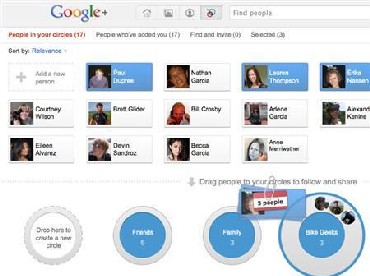Photographs: Reuters Priyanka Joshi in Mumbai
Social networking sites like Facebook and Twitter continue to lead, but Google's bid to reverse its curse has got everyone interested.
With 60 per cent of India's online audience logging on to social networks, according to online audience measurement and analytics platform ViziSense, the introduction of Google's latest social networking site, Google+, has made Facebook and Orkut users sit up and take notice.
With hundreds of Facebook users from India already on Google+, which has allowed select numbers of users from around the globe to test the site and is in a beta testing phase, the initial user reactions seem encouraging.
...
Users give Google+ the thumbs up
Photographs: Tobias Schwarz/Reuters
Google+ is the search engine giant's latest attempt to carve its place into the people-centric territory, where Facebook has a 54 per cent reach among the 100 million internet audience in India. Twitter enjoys a four per cent market share.
"When Google launched Gmail seven years ago, people went crazy to get an invitation from peers. In every blog and every forum, people were requesting an invitation. Now, the same is happening with Google+. It's natural for people to get attracted to it, as it's open only to a select few. It's becoming like status: Hey, I have a G+ account. Some are even selling G+ invites on eBay for $0.99," says Dhiraj Kapasi, a software tester in New Jersey, who joined Google+ last week.
Mahesh Murthy, the founder of pay-for-performance digital marketing firm Pinstorm, has also moved on to Google+ and claims he spends more time on it than on Facebook.
...
Users give Google+ the thumbs up
Photographs: Lucas Jackson/Reuters
"This is because it offers a huge benefit over Facebook, where everything you say is to everybody. On Google+, it's easier to build groups or circles of different people, say family, colleagues, alumni and such, and only share content with the group you want to share it with," says 45-year Murthy, also a co-founder of VC fund Seedfund.
Murthy has 5,000 friends on Facebook. "Facebook neither lets me grow that number nor lets me take their details elsewhere so that I can create a group with my own friends. This is stupid," he says.
That's where Google+ scores: It puts no limit on the number of friends a user can have.
Google's earliest attempt at social networking, Orkut, boasted 80 per cent of India's internet market just four years before.
The site, which receives 35 per cent of its traffic from India, continues to roll out features like integration of Google maps for small business owners and a 'like' feature for posting reactions to friends' stories.
...
Users give Google+ the thumbs up
Alok Kejriwal, a 42-year internet entrepreneur, recalls Orkut as his first social media website. "I liked the fact that I could see who had visited my Orkut profile page. It was a nice voyeuristic experience, but I moved away when the site became sleazy and tacky," he says.
With Kejriwal's business thriving on social media, he says he hires, seeks ideas, gets feedback, and even 'friendsources' work to his 10,000 contacts across social sites like LinkedIn, Facebook, Twitter, etc.
Social media is no longer just a medium to chat with friends. Users like Kejriwal also bank on these sites to complement their professional needs. That's another area where Google+, dubbed a project by the company rather than a product, hopes to score.
Google+ is a loosely stitched-together-version of existing Google services like Picasa, blogger and some influenced by Facebook.
...
Users give Google+ the thumbs up
Photographs: You Sung-Ho/Reuters
For instance, Google+'s Stream is Facebook's News Feed, and the +1 button is an open imitation of the Facebook Like button.
What Google offers that Facebook doesn't is features like Sparks, a special-interest search engine that helps you find stuff on the web to share with your pals, with topics ranging from recipes to robotics.
It also builds in a fundamental principle of Twitter that allows a member to follow others without seeking their permission, and it's a unidirectional action that doesn't require them to follow you back.
But Google has to impress users like Hareesh Tibrewala, a serial entrepreneur and social media evangelist, who has joined the list of Google+ users.
...
Users give Google+ the thumbs up
Photographs: Arnd Wiegmann/Reuters
"I am a little skeptical about Google, as it has made many false starts earlier in social media and has pretty much not got anywhere. Unlike any other technology where features are an important driver, here, the driver will be the network. If lots of my friends move to Google+ and life starts manifesting on this site, then I, too, will spend more time on Google+," he says.
Google also has a tough task to impress the 30 million Facebook users in India to try its project.
According to ViziSense, an average user spends about 15 minutes per visit on Facebook, but that might change with young users like 23-year Arjun Tomar, a VFX artist.
Tomar claims, "You cannot be loyal to a social media website. Being sociable comes with a huge desire to abandon the tried and tested and trying the new and exciting. And, with Google's extremely clever marketing ploy, more and more people are lining up to join the + bandwagon."
...
Users give Google+ the thumbs up
Photographs: Reuters
He says he was on Facebook long before it was accessible to the general public. "Being a student of Georgia Institute of Technology, I was one of the people who used Facebook when it was meant exclusively for college students and that's what attracted me most to it, the exclusivity. As everyone came on board, it just lost its appeal to me," he reasons.
If it wasn't for users like 27-year Abhishek Shroff, a business development executive with Educomp, who swears by the need to be connected with his friends on Facebook, founder Mark Zuckerberg would have been a restless man today.
Shroff, who continues to use Orkut albeit just once a month, prefers to spend his time on Facebook. "I don't see anything that Google+ offers that Facebook doesn't already," he feels.
With inputs from Shibangi Das









article